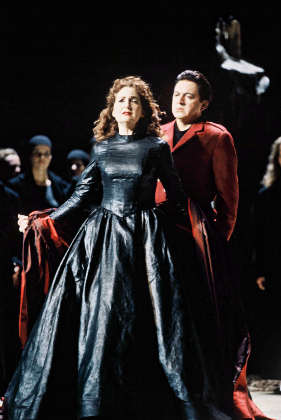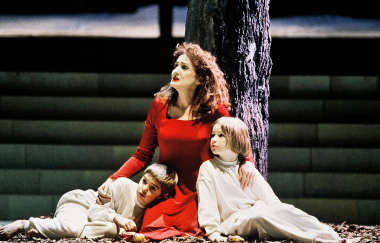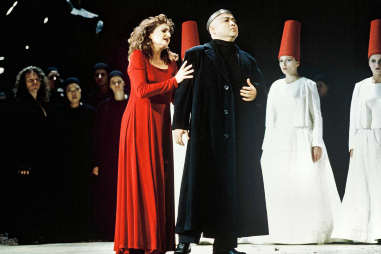|
Editorial Board
Melanie
Eskenazi
Webmaster: Len Mullenger
|
Seen and Heard International
Opera Review
Bellini, Norma at Staatsoper Under den Linden, Berlin, 10.11.2006 (GF)
Staatsopernchor and Staatskapelle Berlin/Giuliano Carella
Even if we don’t regard Norma
as a war opera in the first place, martial activities
play an important role in the proceedings and conductor
Giuliano Carella had obviously taken this as his starting-point,
since right from the beginning he let loose the Staatskapelle’s
bellicose inclinations with a force and a power that had
one reaching for the programme to see if it was actually
an early Verdi opera and not the promised Bellini masterpiece.
But it was Bellini and the explosive overture, fast and
relentless, gave premonitions of an unusually thrilling
but probably unsubtle reading of the score. In the main
this was also what it turned out to be: whenever he saw
a chance Maestro Carella aimed for maximal intensity and
also did what he could to drown the soloists. This latter
object largely missed its target, however, since he had
reckoned without his cast, whose uniformly glorious singing
could ride the orchestra with ease. Maestro Carella should
also be credited for actually being quite obliging towards
his soloists in many of the lyrical outpourings, notably
the long scenes with Norma and Adalgisa. Even though this
is generally regarded as Bellini’s masterpiece it
has weaknesses: the orchestration is at times quite primitive
and there are some tunes that are quite banal. The druids’
chorus at the beginning of act one, for example, and in
maestro Carella’s reading it became more mincing
than ever, but probably he wanted to get it done with
as fast as possible. At the end, after the final eruption,
when we had loosened our mental safety-belts, we couldn’t
help nodding approvingly to each other, my wife and I,
and on the bus back to the hotel we agreed that this was
by some distance the most thrilling Norma we
had ever heard, whether live or on records. We wouldn’t
want to have it served so near the boiling-point every
time – some of the poetry inevitably evaporated
in the process – but there was still enough left
to savour.
The opera is – originally – set in Gaul during
the Roman occupation, about 50 B.C. No director with self-respect
seems brave enough nowadays to stick to the original intentions.
Annegret Ritzel, when staging this production seven years
ago, chose to transport it to something looking like fairly
modern times, judging from the costumes. The Druid soldiers
arm themselves with Kalashnikovs before the expected Roman
attack but Oroveso is still carrying a spear, making him
look like a lost Wotan. The stage picture is a flight
of stairs with a transparent window-like construction
being lowered at the back of the stage when the action
is indoors and lifted again when it is outdoors. To the
right, whether in- or outdoors, there is a fireplace with
a mantel-piece and two modern-looking armchairs. When
Norma’s two children, charmingly acted by two cute
boys, made their first entrance one of them was carrying
a fairytale book with colourful pictures and both children
sat together in one of the chairs “reading”
and turning the pages, which caused some amused giggling
from the audience. The chorus, in the mass scenes, seemed
to move around a little at random and I also got the feeling
that the soloists were left to their own discretion, but
with such electrifying singing and high-voltage playing
from a Staatskapelle seemingly on their toes, it didn’t
matter much. The sets were rather beautiful and the final
scene, when Norma and Pollione are to mount the funeral
pyre, was accompanied by evocative flames and smoke seen
at the back of the stage.
Pictures © Monika Rittershaus Back to the Top Back to the Index Page |
| ||
|
||||





